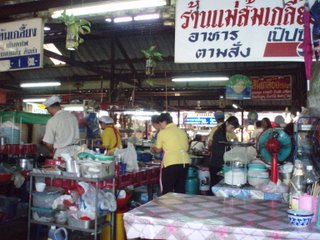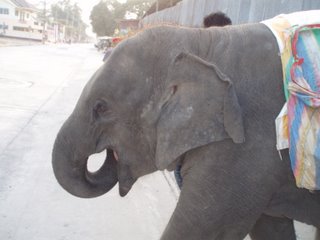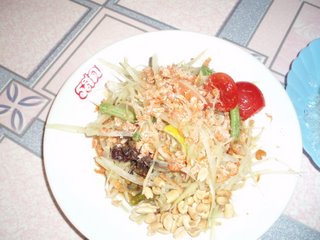So, I know what you are all wondering. What are you eating over there? Thai food three meals a day should be fabulous and amazingly delicious, right? Sometimes. Unlike in the West (particularly in the States), Thais don't distinguish food between the three meals. No one in America is going to stop you from eating cereal for dinner or spaghetti and meatballs for breakfast, but it is common to have certain foods for certain meals of the day. We eat breakfast and lunch in the school canteen (cafeteria) and if I didn't look at the clock, I wouldn't know which meal it was. This morning, breakfast was rice with pork and chili stir-fry, sliced fried Thai hot dogs, and an unidentifiable curry. Teachers can have any or all that we want. For students, a plate of food is 25 cents. Lunch is similar everyday: pork noodle soup topped with sliced pork (noodle sizes vary, as does the color of the broth), or rice with any four curries or stir frys. Today, it was big, wide noodles for the soup. For the rice, choices were red chicken or pork curry with eggplant, chunky chicken and mushroom soup with white pumpkin, some sort of squid stir fry, and fried scrambled eggs with shredded greens. Everyday it's a little different, but usually everything is heavily laced with pork. For those of us who are kosher, this makes things difficult. Ok, so I'm far from being Kosher, but I'm not eating much pork these days. This may be due to the small, rural road near the house, which shows the sad life of a pig in under a kilometer. There is a big pig stable (the orchestra from the hungry beasts is deafening, and I won't even mention the stench) on the left. A few hundred yards away is a street vendor selling giant slabs of fly-ridden pink meat, feet, heads, and guts in the afternoon sun, without refrigeration. Across the street is a small outdoor restaurant with a grill outside roasting up chunks of very fresh pork. The sight of all this makes me want to go vegetarian (maybe even vegan), but over here, I think I would starve.
My family has caught on to my semi pork-free diet, thankfully. It seemed like every dish was spiked with some form of pork. They have started buying chicken curry for me from the night market in "downtown" Chachoengsao. Wanida's sister buys all the raw ingredients- exotic veggies, squid, shrimp, fish, pork, eggs, etc.- for the restaurant here. The curry is great, but a word to the wise: eat it slow! The big purple chunks are liver, the small circles are hearts, the long bones with little meat are necks, and the rest I don't want to think about. Usually I pick out the eggplant and small pieces of white meat (avoiding the curls of skin) before placing it in my bowl. This is how Thais eat. For dinner, I am handed a big bowl of rice and sit down at the table, loaded with four or five bowls of food. One is usually "dry," and the rest are soupy. I spoon about two bites worth of food onto one part of my rice, eat it, then reach for more. I like this. It means you don't have to commit to one dish, and you can pace yourself. It's buffet-style, without the American-sized portions.
We have been having gaeng gai (chicken curry) fairly often recently, which I don't mind. Other favorites are tom yung koong or tom chud- bowls of clear pork broth with chunky fried pork or ground pork sitting at the bottom, topped with flavorful fried greens. There is always a bowl of hard-boiled eggs and tofu chunks in dark brown liquid for Wanida's father, who slurps it down with his rice every night. I tried it for the first time last night. All Wanida could say was the broth was made from the bark of a tree and the neck of ducks. Well, it was pork-free, so I grabbed a tofu chunk. I think the "tree bark" must have been cinnamon. It wasn't too bad, if I didn't think about the duck necks.
Well, we must remember it is Asia, which means there is bound to be weird food. Here are some of the mosat strange things That people say are edible:
1. A waffle topped with chili ketchup, sweetened condensed milk, shredded dried pork, and sprinkles
2. Fish pressed together, sun-dried, then deep-fried
3. Fish pieces mashed up with chilies and coconut milk and cooked in a banana leaf over a hot grill (this was delicious)
4. A popular sweet that comes in a bag- one scoop of sugar, one of corn, one of cooked white beans, one of raw red beans, one of yellow beans, and three scoops of tapioca in various shapes and colors, all topped with hot soymilk
This list is not finished!






